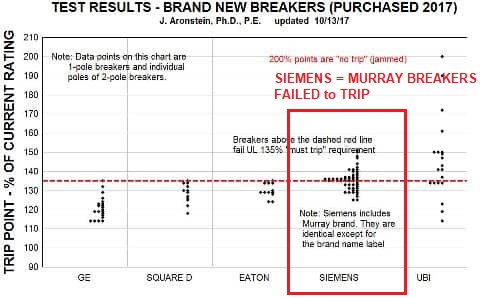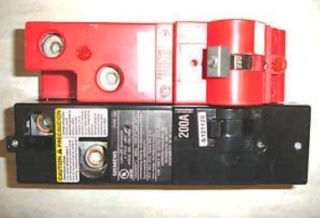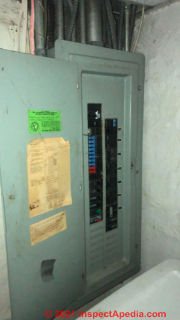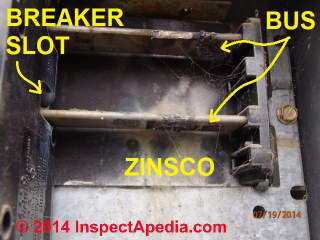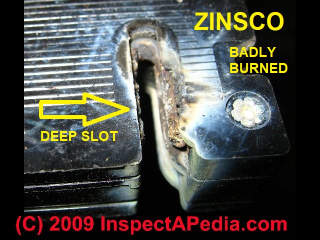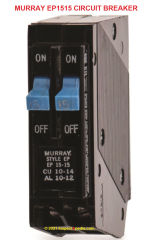 Murray Electrical Panel / Breaker Hazards
Murray Electrical Panel / Breaker Hazards
Independent test reports on Siemens-Murray Circuit Breaker Failure Rate, Recall, Replacements
- POST a QUESTION or COMMENT about Murray electrical panels
This article describes safety hazards found in Murray (and Siemens) circuit breakers used in Murray or Siemens electrical panels and discusses Murray breaker failure data, causes, and breaker replacement alternatives.
Page top photo: A Murray / Bryant EP1515 type circuit breaker.
We include excerpts from a Siemens - Murray breaker recall notice.
InspectAPedia tolerates no conflicts of interest. We have no relationship with advertisers, products, or services discussed at this website.
- Daniel Friedman, Publisher/Editor/Author - See WHO ARE WE?
Murray Electrical Panel / Circuit Breaker Safety Warnings
Certain circuit breakers that fit in Murray electrical panels may be significantly less-safe than most other brands, whether new (Siemens- Murray as tested) or used (sampled from existing electrical panels).
[Click to enlarge any image]
The Siemens-Murray circuit breakers tested in this study joined UBI as poor performers with significant rates of failure rates among the breakers tested by Dr. J. Aronstein in a 2017 study of the response of circuit breakers to an over-current.
The graph excerpt shown here, excerpted from CIRCUIT BREAKER FAILURE RATES illustrates that among the breakers tested, the "UBI-Siemens/Murray" breaker was the worst- performing in both new circuit breaker tests. Used UBI-SIemens/Murray breakers performed equally poorly. For those who wish, both that article and also links at the end of this page take readers to the original research.
Readers should note that both new and used Siemens / Murray circuit breakers performance was similar ( and poor).
Design Features May Explain poor Murray Breaker Performance
Other sources in the electrical industry cite component design features of Murray / Siemens breakers as possible sources of the circuit breaker's poor performance [more expert research citations needed ]
- Failure of bimetallic strips in the breaker due to wear and tear or due to repeated exposure to heat; in addition to the Murray recall notice given below, there may be a more-widespread failure of this component in Murray/Siemens breakers thus reducing the circuit breaker's ability to respond properly to an over-current.
Similarly, repeated exposure to over-current and thus to heating of the bi-metallic spring may cause the spring to weaken (the breaker may then fail to trip in response to over-current) - Limited current surge tolerance: in a usage exposed to frequent high but brief current surges the Murray/Siemens breaker may fail to operate properly.
Murray breakers may tolerate 3-4 x rated load current, a level significantly-less than other brands. In our OPINION this would be a convenience issue in that if a breaker trips off more often than wanted it's a nuisance, but it's failing in the "safe" direction" if it turns off power.
Alternatives & Replacements for Murray - Siemens Circuit Breakers
Watch out: there are two separate "no-go" circuit -breaker substitution issues:
- The breaker may "fit" in the panel but be unsafe or un-listed / un-approved for that use.
First you don't want an electrical fire or injury. If you suffer a fire or injury loss, don't be sure that your insurance company will pay-up if your electrical system used improper or un-approved parts. - The breaker may be physically a completely different line that won't even fit but may have a confusing name or label - resulting in a wasted purchase that typically is not refundable. In some cases there are also safety and performance differences as well.
Eg: Crouse-Hinds-Murray circuit breakers are a different product than Siemens/ITE-Murray circuit breakers. The circuit breaker mounting and bus connections in the panel differ. These two circuit breaker lines are not interchangeable.
Aronstein points outthat these two breaker types also differ substantially in their performance, hence in their safety. (Aronstein 2021)
Murray circuit breakers, classed as "single pole thermal-magnetic circuit breakers", have, according to Siemens, an equivalent breaker in the Siemens breaker series.
For the specific case in which two electrical panel brands are both manufactured by the same company AND where the company specifically recommends and permits cross-brand substitution of breakers between those panels, that substitution, provided the right breaker type and properties are selected, should be acceptable to your local electrical inspector..
Warning on Cross-Brand Circuit Breaker Substitution
Watch out: the use of a manufacturer's circuit breaker in electrical panels of other brands is usually not UL-Listed for nor approved by breaker manufacturer.
Watch out: Check the panel labeling as well as manufacturer's labeling and product descriptions to see what circuit breakers are listed and approved for use in that panel.
- Crouse-Hinds type "Murray" circuit breakers are not the same product and cannot be substituted for Siemens/ITE "Murray" circuit breakers. Those are different products and they are not interchangeable.
The two types of circuit breakers have different mounting and are not interchangeable in the panels. The two types are also substantially different in performance (safety). - Cutler Hammer CH breakers (some models) may "fit in a Murray panel but may violate the electrical code.
Watch out: Some sources note that Cutler-Hammer circuit breakers OR Square-D circuit breakers are a "safe, good-performing alternative circuit breaker" that will work in Murray and Siemens electrical panel.
However even though a Brand "X" circuit breaker may "fit" into a Brand "Y" panel, that can leave electrical code acceptance, safety, and legal or even insurance-coverage issues when using cross-brand electrical parts.
- Murray circuit breakers are sold as used and "reconditioned" or "refurbished" by some vendors.
We have not found consistent data describing what this reconditioning involves, and in our OPINION either there may be no actual improvement in the safety of used or "reconditioned" breakers. But there is a definition of "refurbished circuit breaker" -
See DEFINITION of REFURBISHED CIRCUIT BREAKER
We have not found (June 2021) any publicly-available technical description of exactly what is being done to make certain "reconditioned" breakers safe and reliable for re-use. Independent testing has, as we reported above, found significant failure rates in used and new Siemens & Murray breakers.
Here is a list of MURRAY CIRCUIT BREAKER ID NUMBERS [text file]
[Click any image for more detail]
- Siemens circuit breakers like the Siemens QS circuit breaker (Black circuit breaker in the photo above) are described by some sources (Home Depot stores and Amazon) as equivalent and thus fitting in Murray panels, but in fact they are not listed for that use.
Amazon listed the Siemens QS2150 / QS2200 as a replaceent for Murray or Crouse inds MD Type H withoffset lugs
Watch out: specifically, Siemens QP or QT circuit breakers are not interchangeable with Murray MP or MT breakers.
Watch out: this warning is quoted from the Amazon web page where the Siemens QS breakers, shown just above, are listed as "Siemens QS2150 or QS2200 Replacement for Murray Crouse Hinds MDH2150 or MDH2200" - retrieved 2021/06/24,original source: https://www.amazon.com/Siemens-QS2150-Replacement-MDH2150-MDH2200/dp/B075918BP3
Website excerpt:
Watch out: Product description
WARNING! NO REFUNDS OR RETURNS READ COMPLETE LISTING BEFORE YOU BUY!!!
This is a Siemens type QS that will replace the Murray or Crouse Hinds MD type H with offset lugs as in pictures. The replacement breaker you will receive is the Siemens QS black breaker pictured at the bottom
.!!!!WARNING REPLACEMENT of a MAIN CIRCUIT BREAKER is NOT a JOB FOR THE SHADETREE ELECTRICAN, HANDYMAN, NEIGHBOR or any NONQUALIFIED PERSONAL
THIS BREAKER PURCHASE IS NOT RETURNABLE or REFUNDABLE!!
Buyer can choose ONE of the following amperages type QS2125 "125 amp", QS2150 "150 amp" or type QS2200 "200 amp".Amp !!.
We have installed the type QS breaker "black one" in place of the Murray type MD-H "red one" to be sure it works The breaker installs and works perfectly!!!. Everything lines up perfectly when installed.The hold down screw will line up perfectly..
The QS breaker is slightly longer but fits and works perfectly. One CAUTION NOTE! IF YOU ARE HAVING YOUR INSTALATION INSPECTED BY A BUILDING DEPT.!!! THEY MAY NOT ACCEPT THIS BREAKER Consult your electrician to be certain. NOT SURE THIS IS THE RIGHT BREAKER???Email us for help.. !!NO RETURNS or REFUNDS We only ship UPS no PO boxes please..
- Square-D Homeline SqD breakers (not Square-D QO breakers) may "fit" in a Murray panel but they are not listed and so not approved for that use.
Watch out: The company specifically states that their circuit breakes should NOT be installed in electrical panels of other brands.
See an example of this issue
at COUNTERFEIT SQUARE-D CIRCUIT BREAKER RECALL
Thermal-magnetic circuit breakers are explained and their history given
Electrical Code on Circuit Breaker Selection, Mixing, Substitutions, Replacements
In the U.S. the U.S. NEC National Electrical Code (Article 110) requires that circuit breakers installed in an electrical panel be only ones that are approved by the manufacturer (for example as included on the electrical panel door label).
You will note, however, that
Excerpts from Article 110 are below
ARTICLE 110 - Requirements for Electrical Installations
Part I. General
110.1 Scope.
This article covers general requirements for the examination and approval, installation and use, access to and spaces about electrical conductors and equipment; enclosures intended for personnel entry; and tunnel installations.
110.2 Approval.
The conductors and equipment required or permitted by this Code shall be acceptable only if approved.
110.3 Examination, Identification, Installation, Use, and Listing (Product Certification) of Equipment.
110.3(A) Examination.
In judging equipment, considerations such as the following shall be evaluated:
(1) Suitability for installation and use in conformity with the provisions of this Code
Informational Note No. 1: Equipment may be new, reconditioned, refurbished, or remanufactured.
(2) Mechanical strength and durability, including, for parts designed to enclose and protect other equipment, the adequacy of the protection thus provided
(3) Wire-bending and connection space
(4) Electrical insulation
(5) Heating effects under normal conditions of use and also under abnormal conditions
likely to arise in service
(6) Arcing effects
(7) Classification by type, size, voltage, current capacity, and specific use
(8) Other factors that contribute to the practical safeguarding of persons using or likely to come in contact with the equipment
110.3(B) Installation and Use.
Listed or labeled equipment shall be installed and used in accordance with any instructions included in the listing or labeling. - U.S. NEC (2014-2017)
110.3(C) Listing.
Product testing, evaluation, and listing (product certification) shall be performed by recognized qualified electrical testing laboratories and shall be in accordance with applicable product standards recognized as achieving equivalent and effective safety for equipment installed to comply with this Code.
Informational Note:
The Occupational Safety and Health Administration (OSHA) recognizes qualified electrical testing laboratories that perform evaluations, testing, and certification of certain products to ensure that they meet the requirements of both the construction and general industry OSHA electrical standards.
If the listing (product certification) is done under a qualified electrical testing laboratory program, this listing mark signifies that the tested and certified product complies with the requirements of one or more appropriate product safety test standards.
Question: Possible Unsafe Zinsco breakers in a Murray Electrical Panel?
Above: the reader's Murray electrical panel with red, blue, and black-toggled circuit breakers, and an image of the internal of a new 200A Murray load center with a copper bus, as sold at Home Depot stores in 2021. This panel, Murray load center #LC2040B1200CU is equivalent to Siemens 200A Load center #PN2040B1200C.
Home Depot notes (June 2021) that the Murray electrical component brand is being phased out and is replaced by Siemens electrical parts.
Hello,
To me the circuit breakers in this panel look like a Zinsco breaker, but the electric panel is in fact manufactured by Murray.
Are these the same thing or do they share configuration of any kind? - SHB 8 April 2021
This Q&A were posted originally at the InspectApedia.com HOME PAGE
Photo: Murray electrical panel showing red and blue and black toggle switches.
[Click to enlarge any image]
Moderator reply: Murray Electrical Panel Safety Warnings + How to Distinguish Murray from Zinsco Panels & Breakers
That's interesting, thank you for the photo and question asking if Murray Panels carry the same hazard as Zinsco.
The two brands - Murray and Zinsco do not use the same circuit breaker design, as I will illustrate below.
However, after disposing of the question: do Zinsco Breakers fit in a Murray electrical panel (short answer, NO), I include two serious warnings about the Murray electrical panel brand.
I am guessing that your question arose because some inspectors call out or recognize unsafe Zinsco circuit breakers by noting that some of them (not all) carry toggle switches that are other than black. In fact some examples of those are shown in photos above on this page.
In fact while colored circuit breaker toggle switches are characteristic of SOME Zinsco-brand circuit breakers (shown above on this page) there are certainly other circuit breaker brands and models that use red and blue breaker toggle switches.
Just above I illustrate a Murray #P2015 Circuit breaker (used, for sale and described as "refurbished" by an online vendor).
You'll see that this breaker, that fits Bryant or Crouse-Hinds-Murray electric panels is NOT a Zinsco design and would not connect to the Zinsco bus.
The blue toggle is a breaker rated for 15A and the red toggle switch indicates a breaker rated for 20A.
...
Below are photos of the Zinsco bus design and of a Zinsco breaker. You will see that they are both different from Siemens-Murray breakers and also quite distinctive.
If you can have your electrician pull the panel cover off and then post a photo of the bus to which the breakers connect, or post a photo of a side view of a breaker you can know for sure just what is installed in your electrical panel.
Our photo above shows what the bus-bars look like in a Zinsco electrical panel. (Photo courtesy of Tim Hemm)
And above on this page you'll see a side-photo of a Zinsco circuit breaker showing the characteristic very deep slot for the breaker connection to these "on-edge" bus-bars in the panel.
So it's easy to make an unambiguous identification of Zinsco breakers and components; yes those do appear in some other panel brands, like Sylvania.
See details above on this page.
Watch out: A 2017 study by Dr. Jess Aronstein found significant no-trip failures among three brands of circuit breakers (UBI, Siemens/Murray)* and essentially no significant failure rates among three other brands of circuit breakers.
Details are at CIRCUIT BREAKER FAILURE RATES
Detail of 2020 Siemens Murray Circuit Breaker Recall
Watch out: also see MURRAY SIEMENS Recall [PDF] "Siemens Recalls Circuit Breakers Due to Fire Hazard" 23 September 2010 from US CPSC
This recall applies to Siemens - Murray circuit breakers with date codes 0610, 0710 in load centers with date codes between 23 June and 25 August 2010, and for only certain catalog numbers that you will see in the recall notice PDF.
Excerpt:
Hazard: The recalled circuit breakers have a spring clip that can break during normal use, leading to a loss of force to maintain a proper electrical connection in the panelboard. This can lead to excessive temperature, arcing or thermal damage at the connection point, and damage to the panelboard’s electrical insulation and can result in a fire, property damage, or personal injury.
Incidents/Injuries: Siemens has received one report of a circuit breaker spring clip that broke during installation. No injuries have been reported.
Description: This recall involves Siemens and Murray 15 through 50 AMP single and double pole circuit breakers, load centers (circuit breakers that come with an electrical panel), and meter combos (contain a load center and a meter socket).
“Siemens” or “Murray,” date codes 0610 or 0710 and the catalog number are printed on a label on the side of the circuit breakers.
Date codes between June 2010 through August 2010 are stamped on the inside of the metal box of the load centers and meter combos.
The catalog number for the load centers and meter combos is printed on a label inside the metal box door and on the packaging.
Research on Murray / Siemens Circuit Breaker Performance
- Aronstein, J., CIRCUIT BREAKER FAILURE RATES - [Web article] that summarizes & provides links to many circuit breaker test reports.
- Aronstein, Jess 1, (Life Senior Member, IEEE), & David W. Carrier 2 MOLDED CASE CIRCUIT BREAKERS - SOME HOLES IN THE ELECTRICAL SAFETY NET [PDF]
Received December 4, 2017, accepted January 24, 2018, date of publication February 7, 2018, date of current version March 15, 2018. Digital Object Identifier 10.1109/ACCESS.2018.2803298
1 Consulting Engineer, Schenectady, NY 12309, USA, 2 SUNY Dutchess Community College, Poughkeepsie, NY 12601, USA, Corresponding author: Jesse Aronstein (AronsteinJ@verizon.net)
This paper is also available at no charge at the IEEE Explore website. It can be accessed for online reading at: http://ieeexplore.ieee.org/document/8283732/ - Aronstein, Jesse, and Richard Lowry. ESTIMATING FIRE LOSSES ASSOCIATED WITH FPE STAB-LOK® CIRCUIT BREAKER MALFUNCTION [PDF] In Electrical Safety Workshop (ESW), 2011 IEEE IAS, pp. 1-7. IEEE, 2011. - retrieved 2021/06/25 original source: http://www.fpe-info.org/estimating_fire_losses_due_to_fpe_malfinction.pdf
- Aronstein, Jess, to Daniel Friedman, "Critique of Murray Electrical Panel Article", private email, 2021/06/24.
Excerpt:
As best I understand it, Murray took over Crouse-Hinds and produced the same breakers under the Murray brand.
Siemens took over the brand name and produced the ITE type breakers under the Murray brand name.
The Crouse-Hinds "Murray" breakers are not the same as the Siemens/ITE "Murray" breakers.
` The two types have different mounting and are not interchangeable in the panels. The two types are also substantially different in performance (safety). - MURRAY SIEMENS RECALL [PDF] "Siemens Recalls Circuit Breakers Due to Fire Hazard" 23 September 2010 from US CPSC
- Relectric, "What Breakers Can Replace Murray Circuit Breakers?", Relectric, [a replacement circuit breaker and re-conditioned circuit breaker provider], retrieved 2021/06/13 original source: https://www.relectric.com/blog/2017/11/27/what-breakers-can-replace-murray-circuit-breakers/
This company suggests three replacement circuit breaker types for Murray though as we discuss above, "works" or "fits" is not equivalent as "code-permitted" nor, in some cases "safe" .
Air circuit breakers (for voltages less than 450V)
Square-D circuit breakers (see our Listing warning above)
Cutler-Hammer Circuit breakers - UBI FPE CIRCUIT BREAKER TEST RESULTS [Web article] summarizes independent test results on UBI circuit breakers used to replace FPE Stab-Lok® circuit breakers find high failure rates and provides links to original test reports.
and can be downloaded directly from IEEE at http://ieeexplore.ieee.org/stamp/stamp.jsp?tp=&arnumber=8283732
...
Continue reading at MURRAY SIEMENS RECALL [PDF], or select a topic from the closely-related articles below, or see the complete ARTICLE INDEX.
Or see these
Recommended Articles
- CHALLENGER ELECTRIC PANELS
- CIRCUIT BREAKER FAILURE RATES
- CIRCUIT BREAKER FAILURE RESEARCH
- CIRCUIT BREAKERS RE-CONDITIONED USED
- ELECTRICAL PANEL AGE
- FPE Stab-Lok® : FIRES WAITING TO HAPPEN
- IDENTIFY BRYANT ELECTRICAL PANELS
- IDENITFY FRANK ADAM ELECTRICAL PANELS
- IDENTIFY GTE SYLVANIA-ZINSCO PANELS
- IDENTIFY KEARNEY PANELS
- IDENTIFY SYLVANIA ELECTRICAL PANELS
- IDENTIFY WALKER ELECTRICAL PANELS
- IDENTIFY ZINSCO ELECTRICAL PANELS
- MURRAY CIRCUIT BREAKER HAZARDS
- MURRAY SIEMENS Recall
- PRIVATE BRAND/ EMI FPE PANELS
- PUSHMATIC - BULLDOG PANELS Pushmatic Bulldog Circuit Breaker & Electrical Panel Possible Safety & Operating Concerns
- UBI FPE CIRCUIT BREAKER TEST RESULTS
- ZINSCO CIRCUIT BREAKER TEST REPORT
Suggested citation for this web page
MURRAY CIRCUIT BREAKER HAZARDS at InspectApedia.com - online encyclopedia of building & environmental inspection, testing, diagnosis, repair, & problem prevention advice.
Or see this
INDEX to RELATED ARTICLES: ARTICLE INDEX to ELECTRICAL INSPECTION & TESTING
Or use the SEARCH BOX found below to Ask a Question or Search InspectApedia
Ask a Question or Search InspectApedia
Try the search box just below, or if you prefer, post a question or comment in the Comments box below and we will respond promptly.
Search the InspectApedia website
Note: appearance of your Comment below may be delayed: if your comment contains an image, photograph, web link, or text that looks to the software as if it might be a web link, your posting will appear after it has been approved by a moderator. Apologies for the delay.
Only one image can be added per comment but you can post as many comments, and therefore images, as you like.
You will not receive a notification when a response to your question has been posted.
Please bookmark this page to make it easy for you to check back for our response.
IF above you see "Comment Form is loading comments..." then COMMENT BOX - countable.ca / bawkbox.com IS NOT WORKING.
In any case you are welcome to send an email directly to us at InspectApedia.com at editor@inspectApedia.com
We'll reply to you directly. Please help us help you by noting, in your email, the URL of the InspectApedia page where you wanted to comment.
Citations & References
In addition to any citations in the article above, a full list is available on request.
- Our recommended books about building & mechanical systems design, inspection, problem diagnosis, and repair, and about indoor environment and IAQ testing, diagnosis, and cleanup are at the InspectAPedia Bookstore. Also see our Book Reviews - InspectAPedia.
- In addition to citations & references found in this article, see the research citations given at the end of the related articles found at our suggested
CONTINUE READING or RECOMMENDED ARTICLES.
- Carson, Dunlop & Associates Ltd., 120 Carlton Street Suite 407, Toronto ON M5A 4K2. Tel: (416) 964-9415 1-800-268-7070 Email: info@carsondunlop.com. Alan Carson is a past president of ASHI, the American Society of Home Inspectors.
Thanks to Alan Carson and Bob Dunlop, for permission for InspectAPedia to use text excerpts from The HOME REFERENCE BOOK - the Encyclopedia of Homes and to use illustrations from The ILLUSTRATED HOME .
Carson Dunlop Associates provides extensive home inspection education and report writing material. In gratitude we provide links to tsome Carson Dunlop Associates products and services.


